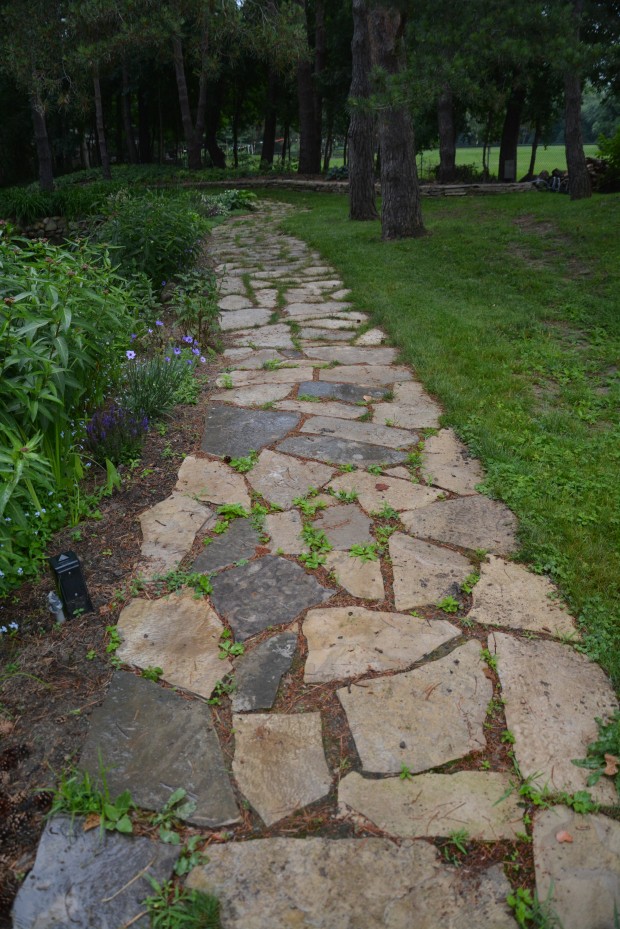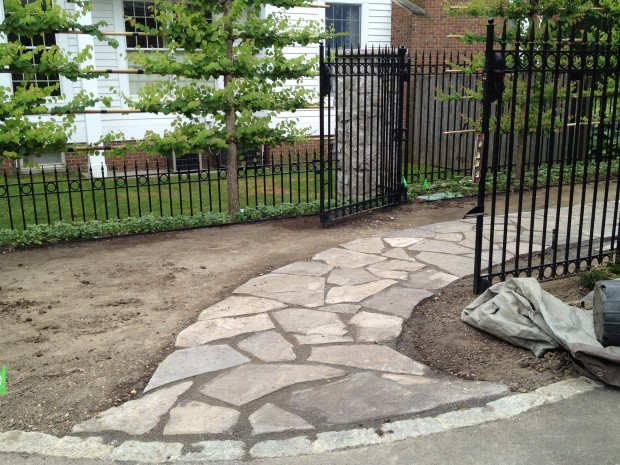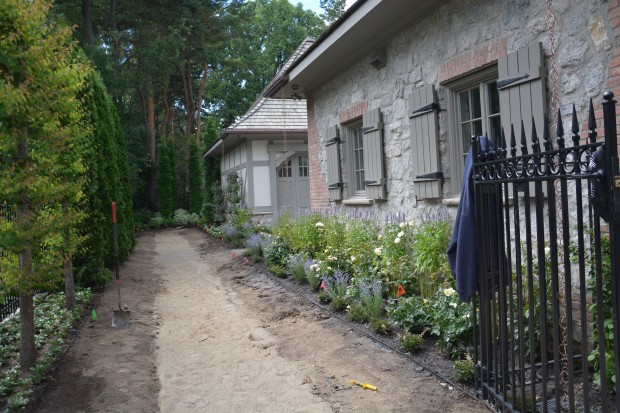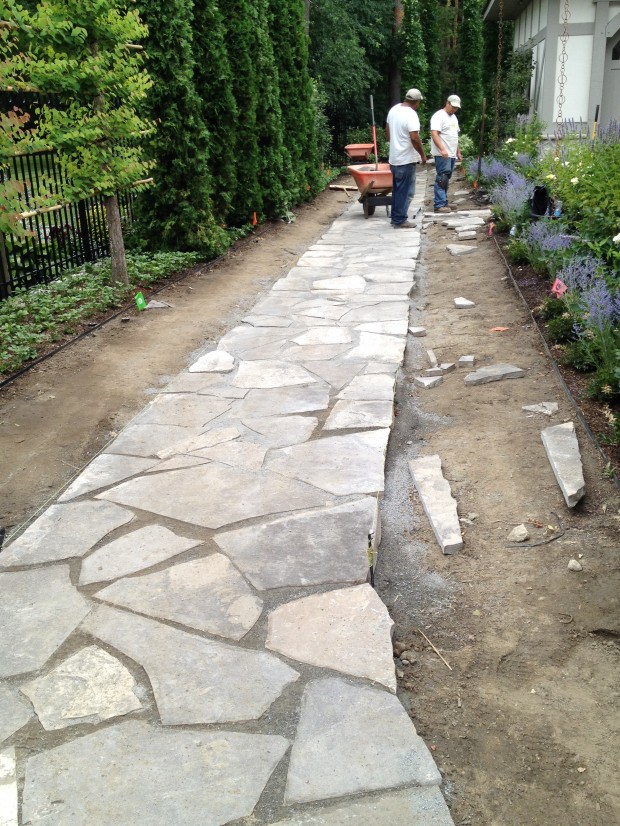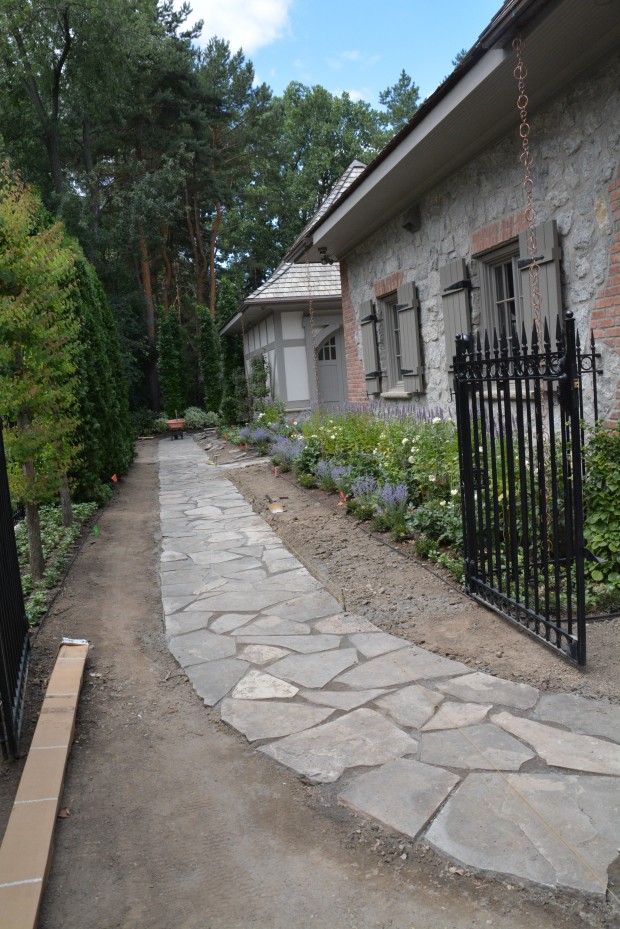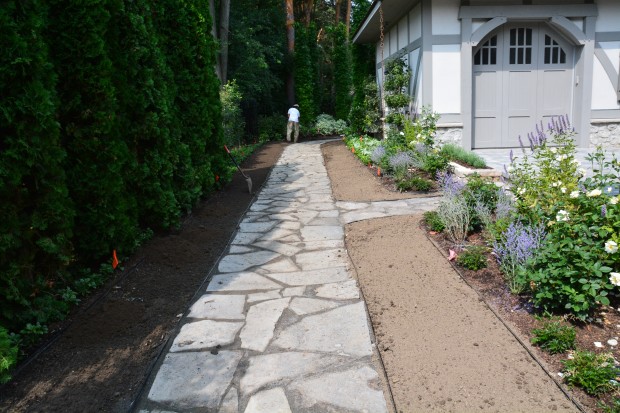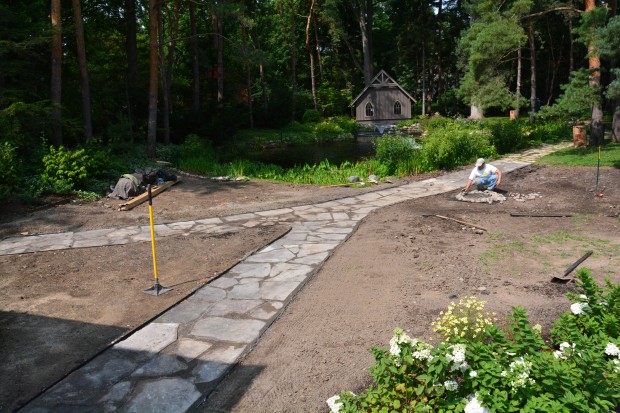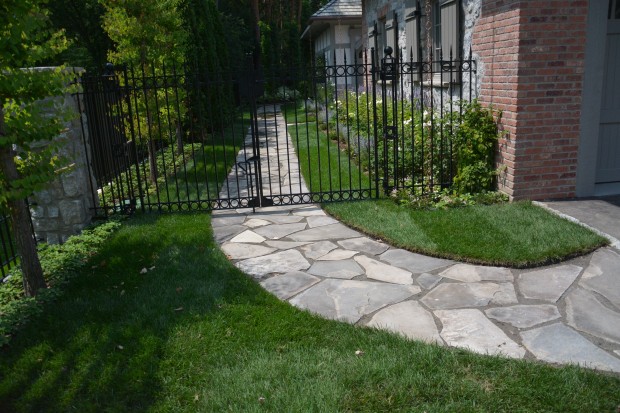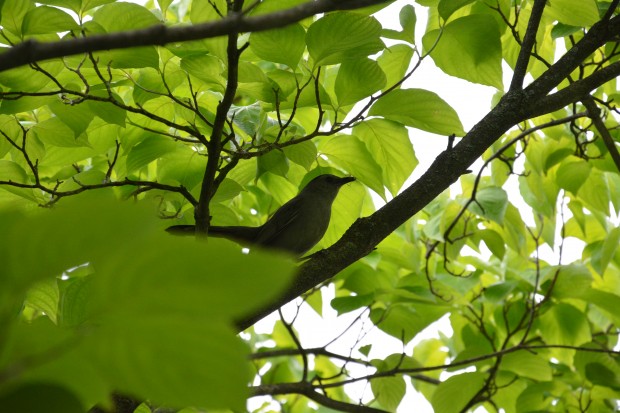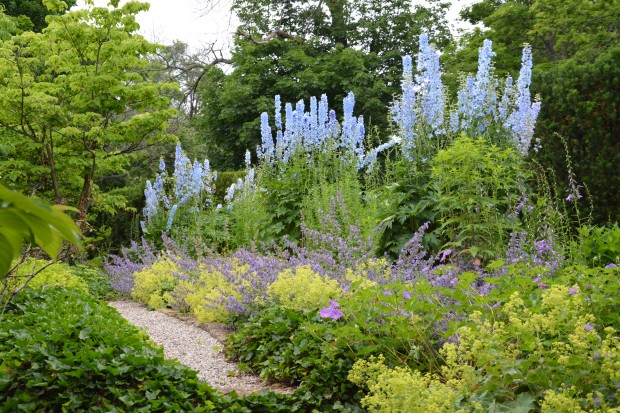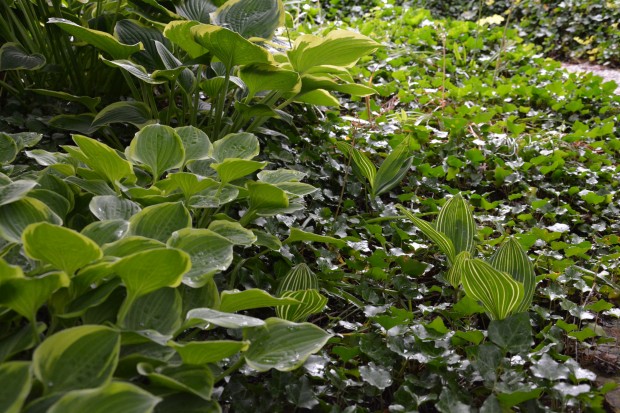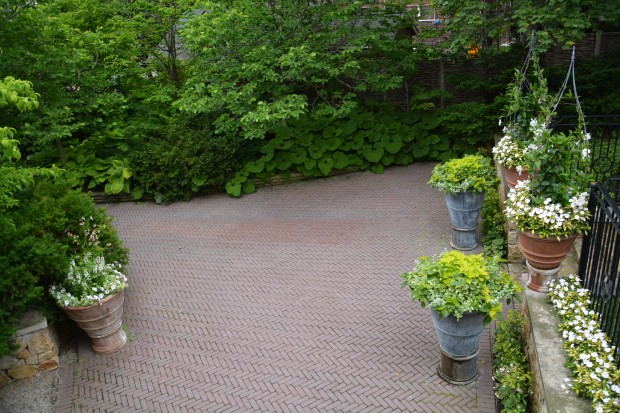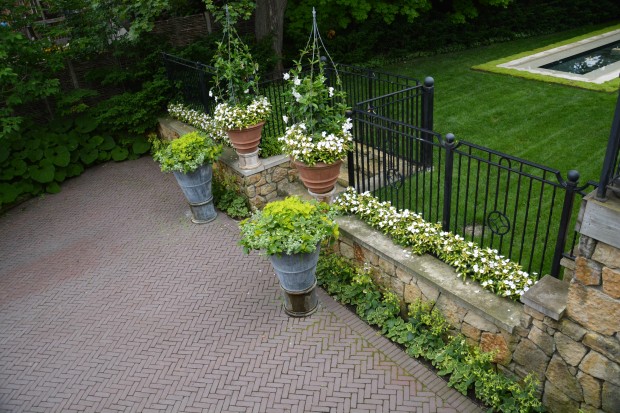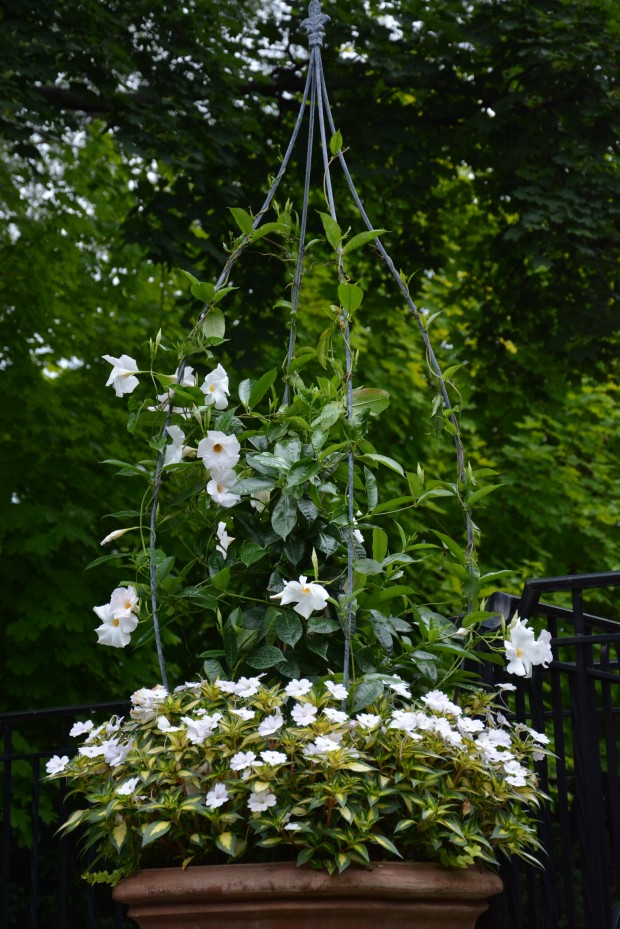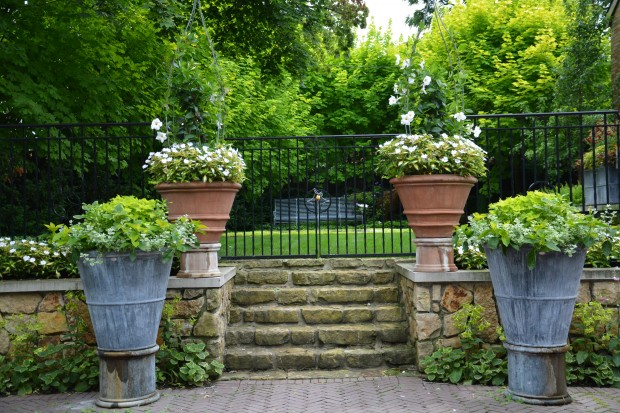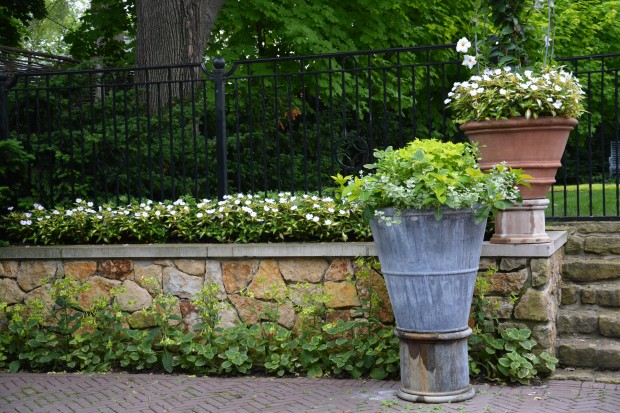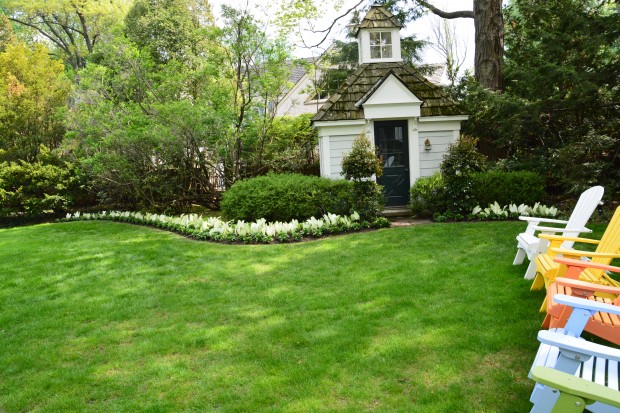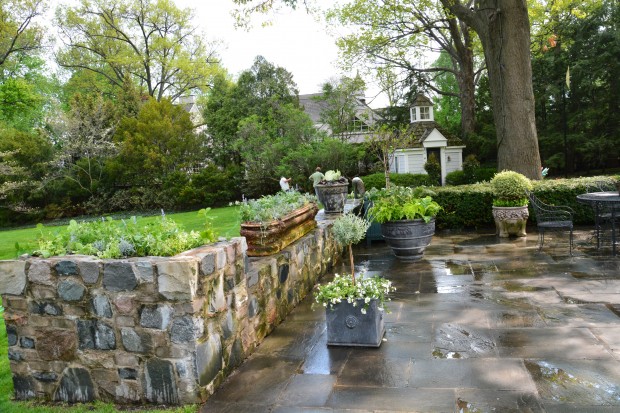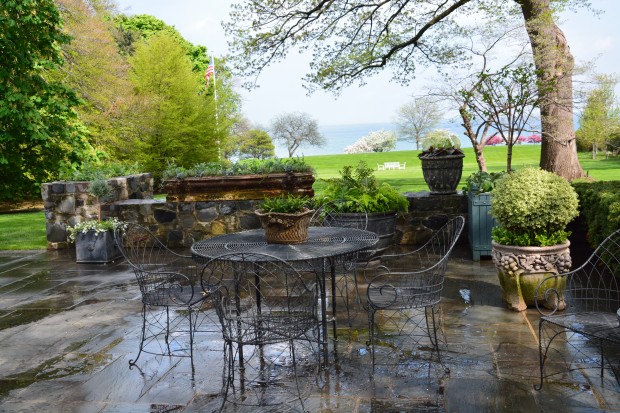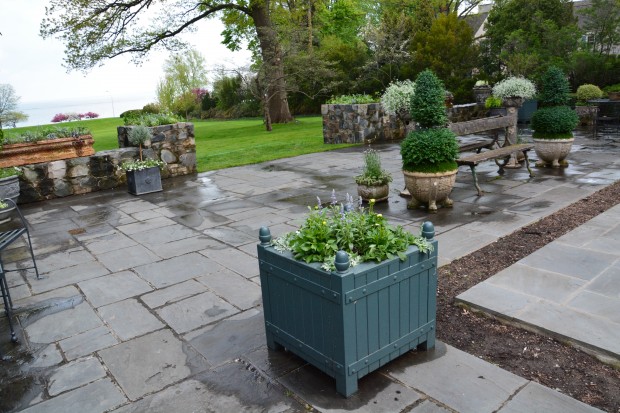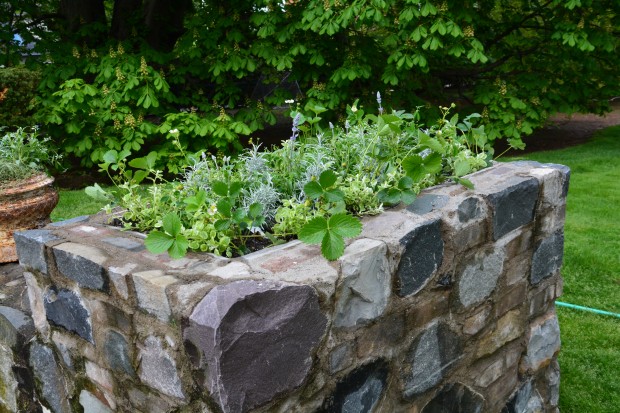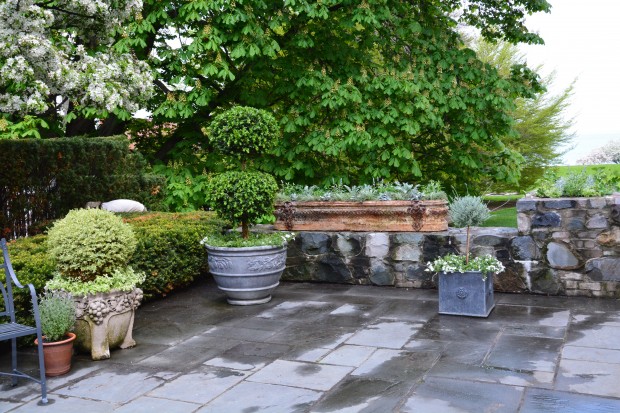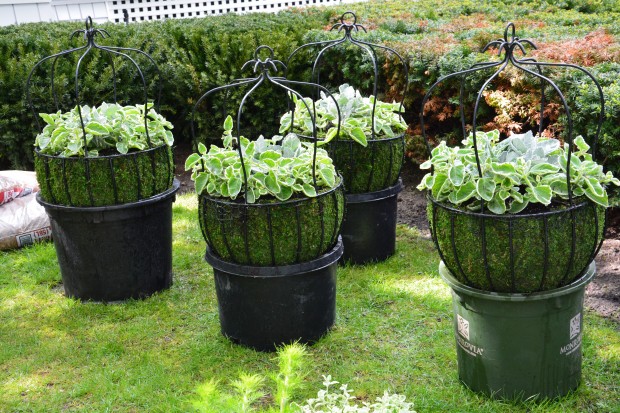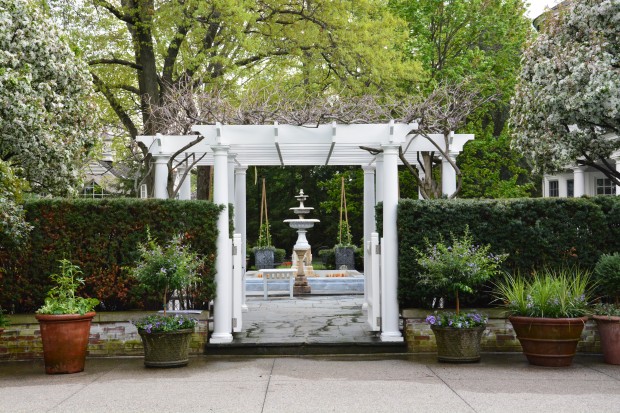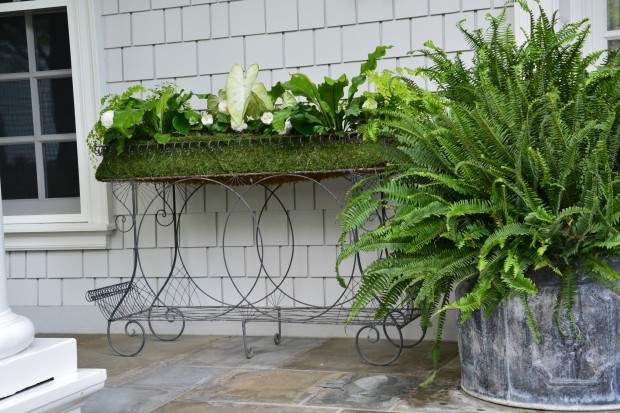 Every gardener is used to seeing containers placed on hard surfaces. On either side of a front porch. On a set of steps or walkway. On a terrace. But containers can fit right into a spot in the landscape. We have worked in several places this week where containers were placed in the midst of the ongoing landscape. I like what I am seeing. Placing pots in the garden is an unusual placement, but unusual can be a good. The first rule of good design is to not take any rule as set in stone. Some of the most beautiful landscape designs I have seen break every rule. By this I mean, they break every rule, but do it convincingly. A great heart, and sure hand always trumps following the rules. I worried myself for days, given the decision to place this pot in the middle of the lawn in the rose garden. Once the deed was done, I wondered why. The placement seemed right.
Every gardener is used to seeing containers placed on hard surfaces. On either side of a front porch. On a set of steps or walkway. On a terrace. But containers can fit right into a spot in the landscape. We have worked in several places this week where containers were placed in the midst of the ongoing landscape. I like what I am seeing. Placing pots in the garden is an unusual placement, but unusual can be a good. The first rule of good design is to not take any rule as set in stone. Some of the most beautiful landscape designs I have seen break every rule. By this I mean, they break every rule, but do it convincingly. A great heart, and sure hand always trumps following the rules. I worried myself for days, given the decision to place this pot in the middle of the lawn in the rose garden. Once the deed was done, I wondered why. The placement seemed right.
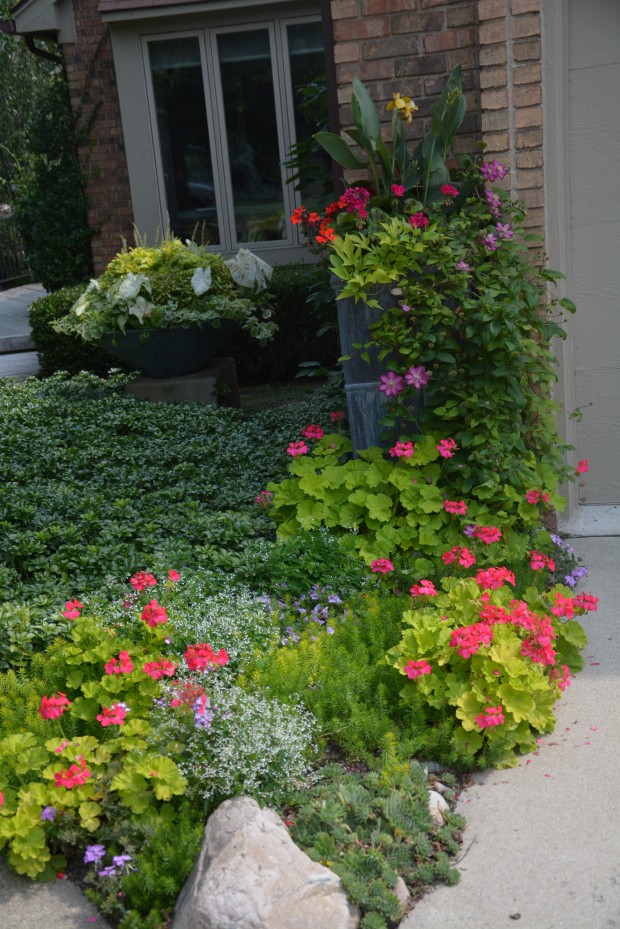 This container is set in a landscape bed. A clematis has climbed and wound itself around a tall steel container. A bed of pachysandra, angelina and hens and chicks has been inter planted with with Persian Queen geraniums, euphorbia, and trailing annual verbena. The look of this garden is better than good. I like how the introduction of annual plants into the landscape, and the perennial clematis climbing the side of a container have created a look in which the container has become an integral part of the landscape. The annuals planted in ground-so charming, and so successful. This planting is not mine-it is all Jane’s. Clients can be a great source of inspiration. They know their gardens backwards and forwards. Their decisions are based on a daily exposure. This corner is invariably burned by salt in the winter, so a summer/seasonal planting helps keep this spot luxuriant.
This container is set in a landscape bed. A clematis has climbed and wound itself around a tall steel container. A bed of pachysandra, angelina and hens and chicks has been inter planted with with Persian Queen geraniums, euphorbia, and trailing annual verbena. The look of this garden is better than good. I like how the introduction of annual plants into the landscape, and the perennial clematis climbing the side of a container have created a look in which the container has become an integral part of the landscape. The annuals planted in ground-so charming, and so successful. This planting is not mine-it is all Jane’s. Clients can be a great source of inspiration. They know their gardens backwards and forwards. Their decisions are based on a daily exposure. This corner is invariably burned by salt in the winter, so a summer/seasonal planting helps keep this spot luxuriant.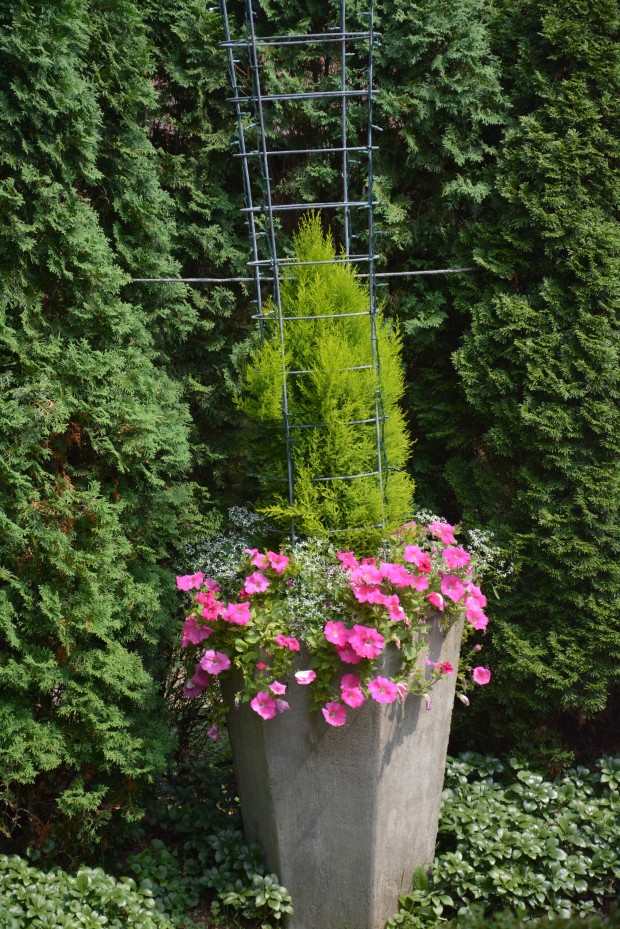 A container set in a landscape bed is one way to create a focal point. This tall concrete pot planted with a lemon cypress, euphorbia, and petunias gives meaning to a landscape comprised of arborvitae and pachysandra. I like the ground cover growing up over the base of this planter. It looks as though the container has been there a while, and belongs there.
A container set in a landscape bed is one way to create a focal point. This tall concrete pot planted with a lemon cypress, euphorbia, and petunias gives meaning to a landscape comprised of arborvitae and pachysandra. I like the ground cover growing up over the base of this planter. It looks as though the container has been there a while, and belongs there.  A pot gracefully placed in a landscape can add another dimension to an outdoor space. Landscapes which offer many dimensions continue to interest the viewer. A pot placed in the landscape is a mark made by a designer. That said, I treasure the individual statement of a landscape above all. Some landscapes I see are all about a gardener in charge with a strong point of view.
A pot gracefully placed in a landscape can add another dimension to an outdoor space. Landscapes which offer many dimensions continue to interest the viewer. A pot placed in the landscape is a mark made by a designer. That said, I treasure the individual statement of a landscape above all. Some landscapes I see are all about a gardener in charge with a strong point of view.
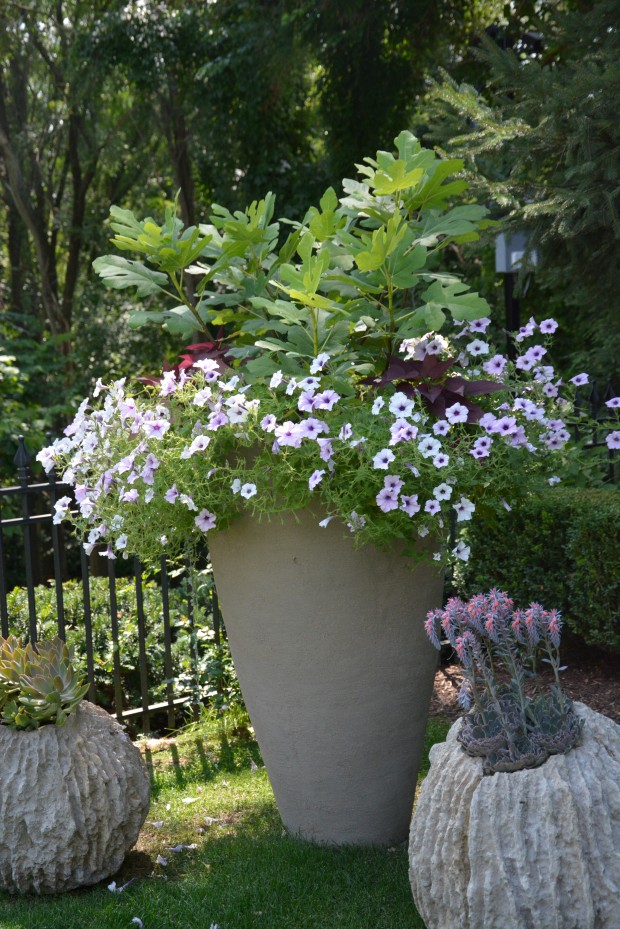 We usually remove the grass underneath a container, excavate the soil, and replace that soil with gravel. The insures that the container drains unimpeded. Trimming the grass around the container is an extra step, maybe even a nuisance. But for the gardener that appreciates the small details, a placement like this is a pleasure. A pot placement in the landscape can be a temporary solution to a bigger problem. In this case, a tree directly behind this group of containers died this past winter. The tree, and its stump was of a size that replacement will not be easy. The pots draw one’s eye away from the empty space. Given this placement of pots, a much smaller tree could be planted which would eventually fill that void.
We usually remove the grass underneath a container, excavate the soil, and replace that soil with gravel. The insures that the container drains unimpeded. Trimming the grass around the container is an extra step, maybe even a nuisance. But for the gardener that appreciates the small details, a placement like this is a pleasure. A pot placement in the landscape can be a temporary solution to a bigger problem. In this case, a tree directly behind this group of containers died this past winter. The tree, and its stump was of a size that replacement will not be easy. The pots draw one’s eye away from the empty space. Given this placement of pots, a much smaller tree could be planted which would eventually fill that void.
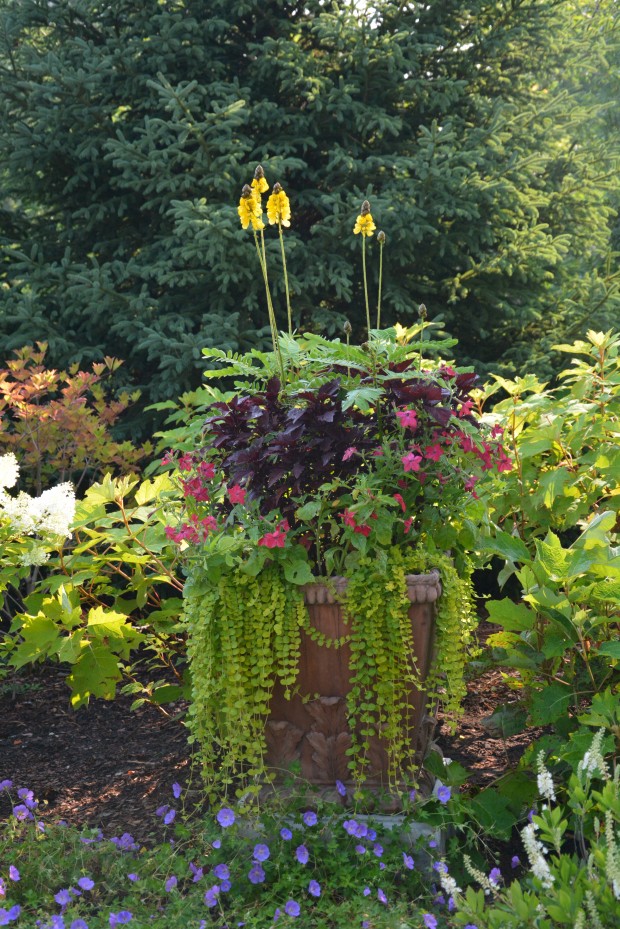 A container in the landscape takes on the same sculptural quality as a birdbath, armillary, or sundial. The small footprint of any of these ornaments makes them easy to tuck into a small space that needs some visual interest. This client has a particular fondness for pots in her borders. This pot is set on a short concrete plinth. That small amount of additional height keeps the bottom of the pot in view, despite the ground covering geraniums.
A container in the landscape takes on the same sculptural quality as a birdbath, armillary, or sundial. The small footprint of any of these ornaments makes them easy to tuck into a small space that needs some visual interest. This client has a particular fondness for pots in her borders. This pot is set on a short concrete plinth. That small amount of additional height keeps the bottom of the pot in view, despite the ground covering geraniums.
 This French glazed pot is of considerable size and stature. It has been placed in a bed of myrtle facing down a stand of mature trees. Pink and red mandevilleas growing on a simple trellis made of bamboo stakes makes a considerable statement by late summer. This spot, minus the pot, would be too sleepy looking for this client. Every gardener wants something different from their garden.
This French glazed pot is of considerable size and stature. It has been placed in a bed of myrtle facing down a stand of mature trees. Pink and red mandevilleas growing on a simple trellis made of bamboo stakes makes a considerable statement by late summer. This spot, minus the pot, would be too sleepy looking for this client. Every gardener wants something different from their garden.
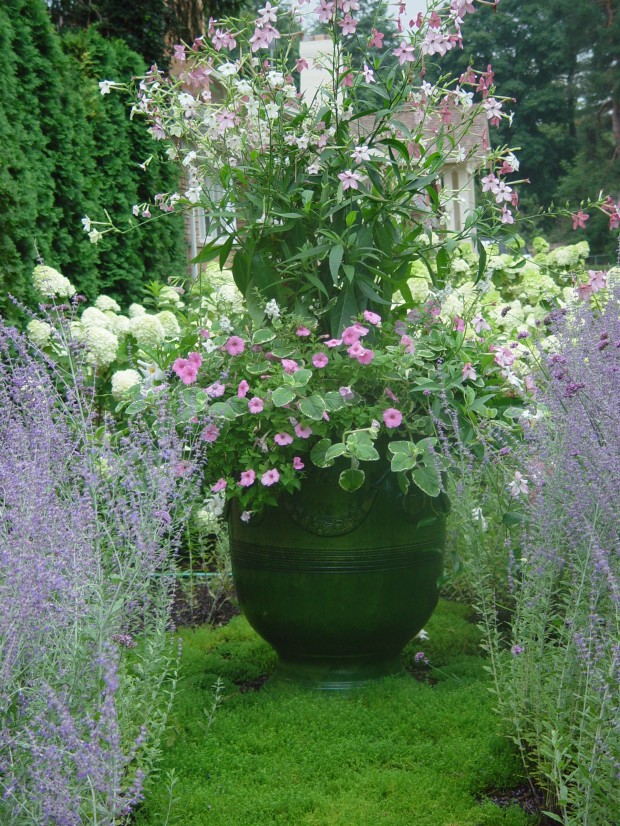 The landscape in the front of my house features two fairly large patches of herniaria. This spot asked for something short that would require little maintenance-it has done very well there. Years ago I set a pair of French glazed pots at opposite ends. A garden ornament which represents the end, or boundary of a garden is called a Herm, 0r a term-as in terminus. Though I have since moved the Russian sage in favor of a simpler arrangement, and switched out the French pot for a concrete pot with a yew topiary that can sit in this spot all year round, the idea is the same. The placement of containers can be anywhere there is a need.
The landscape in the front of my house features two fairly large patches of herniaria. This spot asked for something short that would require little maintenance-it has done very well there. Years ago I set a pair of French glazed pots at opposite ends. A garden ornament which represents the end, or boundary of a garden is called a Herm, 0r a term-as in terminus. Though I have since moved the Russian sage in favor of a simpler arrangement, and switched out the French pot for a concrete pot with a yew topiary that can sit in this spot all year round, the idea is the same. The placement of containers can be anywhere there is a need.
